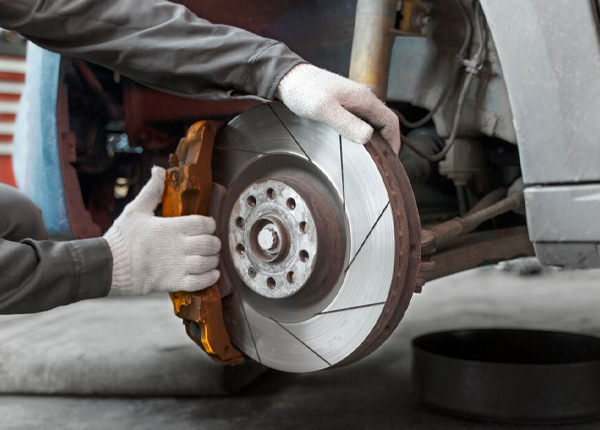The Importance of Bedding In New Brake Pads for Optimal Performance
Alright, let’s talk about brakes. Not the most glamorous topic, I know, but critically important for keeping your vehicle, and more importantly, you, safe on the road. We’ve seen it all at the shop, from near misses to, unfortunately, some not so near misses, all stemming from improperly installed or maintained brakes. One area we consistently see overlooked is the process of bedding in new brake pads. So, what exactly is bedding in, and why should you care?
Bedding in is the process of transferring a thin, even layer of brake pad material onto the rotor surface. Think of it like seasoning a cast iron skillet; you’re creating a stable, protective layer. When you slam on the brakes, you’re not just squeezing the pad against the rotor. You’re actually relying on friction generated between these two surfaces. A proper transfer layer ensures that friction is consistent and even across the rotor, leading to optimal braking performance and longer lasting components. Ignoring this crucial step is like skipping foreplay; you might get the job done, but it waon’t be a pleasant experience, and it could lead to problems down the road.
What Happens If You Don’t Bed Them In?
So, what happens if you just slap on those new pads and hit the road like Mario Andretti? Well, several things can go wrong, none of them good.
Without a proper transfer layer, you risk uneven wear on both the pads and rotors. This can lead to reduced braking power, noise, and vibration. Imagine trying to ice skate on a surface that’s only partially frozen; it’s jerky, unpredictable, and not exactly confidence inspiring. Worse, you could experience something called brake fade, where the brakes lose their effectiveness after repeated hard stops. This is because the uneven surface heats up rapidly, causing the brake pad material to break down and lose its grip. Trust me, experiencing brake fade when you need your brakes the most is a terrifying experience. Think of it like trying to stop a runaway train with a bicycle brake. Ultimately, neglecting the bedding in process significantly reduces the lifespan of your brake components and compromises your safety.
The Bedding In Procedure: A Step by Step Guide
Okay, now that we’ve established the importance of bedding in, let’s talk about how to actually do it. It’s not rocket science, but it does require a little patience and a safe place to perform the procedure.
The basic idea is to perform a series of controlled, progressively harder stops to gradually transfer that pad material. First, find a safe, open stretch of road where you can perform a series of stops without endangering yourself or others. We recommend an empty parking lot or a quiet back road. Once you’ve found your location, start with a few moderate stops from around 30 mph down to about 5 mph. This helps to warm up the pads and rotors. Next, perform several harder stops from around 50 mph down to 10 mph, applying firm, consistent pressure to the brake pedal. Avoid locking up the brakes, which can create flat spots on the pads. After each stop, allow the brakes to cool slightly by driving at a moderate speed for a few minutes. Repeat this process several times, gradually increasing the intensity of the stops. You should start to notice a slight burning smell as the pads bed in. This is normal, but if the smell becomes excessive or you notice any smoke, stop immediately and allow the brakes to cool completely. Finally, after completing the series of hard stops, drive at a moderate speed for several minutes to allow the brakes to cool down completely. Avoid coming to a complete stop during this cooling period, as this can cause uneven deposits of pad material on the rotors. With patience and precision, you’ll create the ideal layer.
Pro Tips and Common Mistakes
Before you go out and start slamming on your brakes, here are a few extra tips to keep in mind.
Different brake pads and rotor materials may require slightly different bedding in procedures. Always consult the manufacturer’s instructions for specific recommendations. For example, some high performance brake pads may require a more aggressive bedding in process. Also, be mindful of the road conditions. Wet or slippery roads can make it difficult to perform the bedding in procedure safely. Wait for dry conditions before attempting to bed in your new brakes. One common mistake we see is people not allowing the brakes to cool down properly between stops. This can lead to overheating and damage to the pads and rotors. Another mistake is using excessive brake pressure, which can cause the brakes to lock up. Remember, the goal is to apply firm, consistent pressure, not to slam on the brakes. With these pro tips and a little caution, you’ll be well on your way to experiencing the full benefits of your new brake pads.
Long Term Benefits: More Than Just Stopping Power
While the immediate benefit of bedding in new brake pads is improved stopping power, the long term benefits are just as important.
Properly bedded in brakes will last longer and perform more consistently over their lifespan. This saves you money on replacement parts and reduces the risk of brake related accidents. Furthermore, a good transfer layer helps to minimize brake noise and vibration, providing a smoother, more comfortable driving experience. Think of it like investing in a good pair of shoes; they might cost a little more upfront, but they’ll last longer, feel better, and ultimately save you money in the long run. So, the next time you replace your brake pads, take the time to bed them in properly. Your safety, your wallet, and your sanity will thank you for it.



